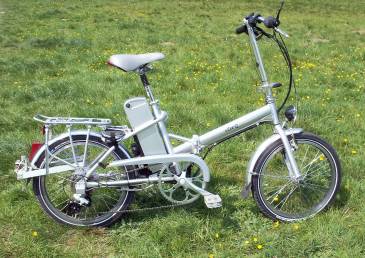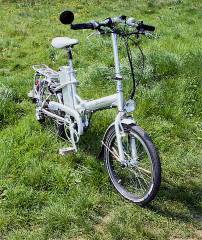The most common reason that people consider buying an e-bike is for help on hills, and I think these bikes should be able to handle anything they meet on our roads with no more effort than the least fit can put in. There should be no compromise in capabilities for anyone, the reasonably short or tall, the thin or fat, the fit or unfit, for hill climbing, load carrying and even towing. On that count virtually all legal e-bikes fail, despite the fact that it can be achieved legally.
One of the worst aspects of e-biking for me has been the very poor bicycle efficiency of most machines, pedalling them without power being all too often a depressing experience for someone who knows what a good bike should be like. The losses inherent in that inefficiency inevitably mean a compromised power and combined performance as well, so there's always been room for big all round improvement. The only exception having some real cycling qualities has been the Giant Twist series, and it's no coincidence that Giant are unique in this field in being a bicycle manufacturer with race experience, knowing what makes an efficient bicycle. Unfortunately it's still fallen seriously short of my minimum requirements due to the lack of power from it's motor unit from Panasonic, another company not traditionally involved in cycle manufacture.
Many of you will know the high regard I have for the eZee Quando II's strengths, it's rear motor stability and comfort, prodigious hill climbing, towing, load carrying abilities, hop on and off utility suitability plus folding as well, though seriously lacking in cycling qualities and having no rider gears. Clearly it's design brief was chiefly that of folding electric bike, leaving it with poor bicycle efficiency for many reasons, this being common in electric bikes though, certainly not just this one. Since it's standard motor, battery and and electrical control set was the only always legal one, no delimiter etc., that could do everything I ask if given an opportunity by combining it with good bicycle design, it was clear this was a good basis on which to build, adding to it's capabilities by making it into a good cycling bike as well, thus creating a truly capable and versatile electric bike.
Notice the difference in philosophy here. eZee also wanted to exploit the Quando's capabilities further, once recognised, but they threw away nearly all of them just for the one trick of power for speed in the Torq. That bike has been good for electric biking publicity and it certainly has it's place in addition, but I think a gain of 1.7 mph over the Q bike in mixed territory is poor recompense for everything else that the Torq lost in comparison. You'll see what I mean later.
Although the Quando looks small in photos, it has a full size strong frame with a full 45” wheelbase giving it cycling potential, and as Alex Moulton showed years ago, small wheels need not be an impediment to efficiency. However, the scale of the problems involved to reach it's full potential meant it was impossible by conventional means and I've previously reported it as not possible. However, problems are there to be solved, so well over two months ago I embarked on using unorthodox methods to achieve this. After much work, the result meets all of my performance aims and also greatly increases the original bike's range. Why Q Bike? Well, it's derived from the Quando, and like the police Q cars, it's capable of much more than it seems to be at first sight.
One of the worst aspects of e-biking for me has been the very poor bicycle efficiency of most machines, pedalling them without power being all too often a depressing experience for someone who knows what a good bike should be like. The losses inherent in that inefficiency inevitably mean a compromised power and combined performance as well, so there's always been room for big all round improvement. The only exception having some real cycling qualities has been the Giant Twist series, and it's no coincidence that Giant are unique in this field in being a bicycle manufacturer with race experience, knowing what makes an efficient bicycle. Unfortunately it's still fallen seriously short of my minimum requirements due to the lack of power from it's motor unit from Panasonic, another company not traditionally involved in cycle manufacture.
Many of you will know the high regard I have for the eZee Quando II's strengths, it's rear motor stability and comfort, prodigious hill climbing, towing, load carrying abilities, hop on and off utility suitability plus folding as well, though seriously lacking in cycling qualities and having no rider gears. Clearly it's design brief was chiefly that of folding electric bike, leaving it with poor bicycle efficiency for many reasons, this being common in electric bikes though, certainly not just this one. Since it's standard motor, battery and and electrical control set was the only always legal one, no delimiter etc., that could do everything I ask if given an opportunity by combining it with good bicycle design, it was clear this was a good basis on which to build, adding to it's capabilities by making it into a good cycling bike as well, thus creating a truly capable and versatile electric bike.
Notice the difference in philosophy here. eZee also wanted to exploit the Quando's capabilities further, once recognised, but they threw away nearly all of them just for the one trick of power for speed in the Torq. That bike has been good for electric biking publicity and it certainly has it's place in addition, but I think a gain of 1.7 mph over the Q bike in mixed territory is poor recompense for everything else that the Torq lost in comparison. You'll see what I mean later.
Although the Quando looks small in photos, it has a full size strong frame with a full 45” wheelbase giving it cycling potential, and as Alex Moulton showed years ago, small wheels need not be an impediment to efficiency. However, the scale of the problems involved to reach it's full potential meant it was impossible by conventional means and I've previously reported it as not possible. However, problems are there to be solved, so well over two months ago I embarked on using unorthodox methods to achieve this. After much work, the result meets all of my performance aims and also greatly increases the original bike's range. Why Q Bike? Well, it's derived from the Quando, and like the police Q cars, it's capable of much more than it seems to be at first sight.
The Q Bike



Here's the illustrated details of all the problems, the ways in which they were solved, and the design thinking involved:
9.5.2007
.
.